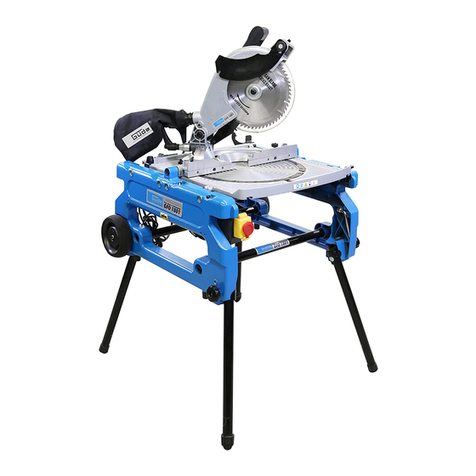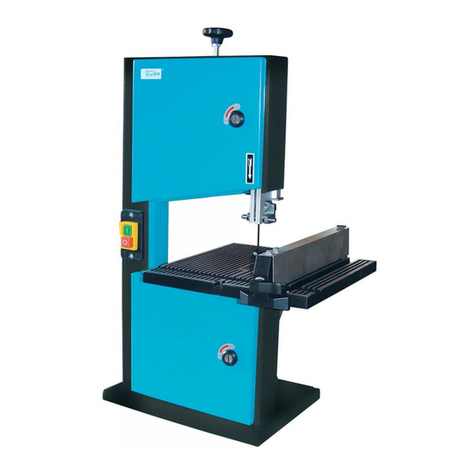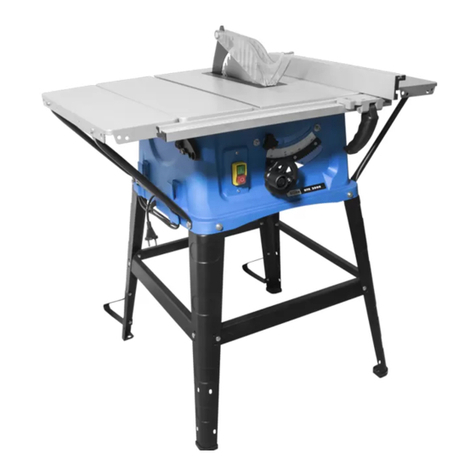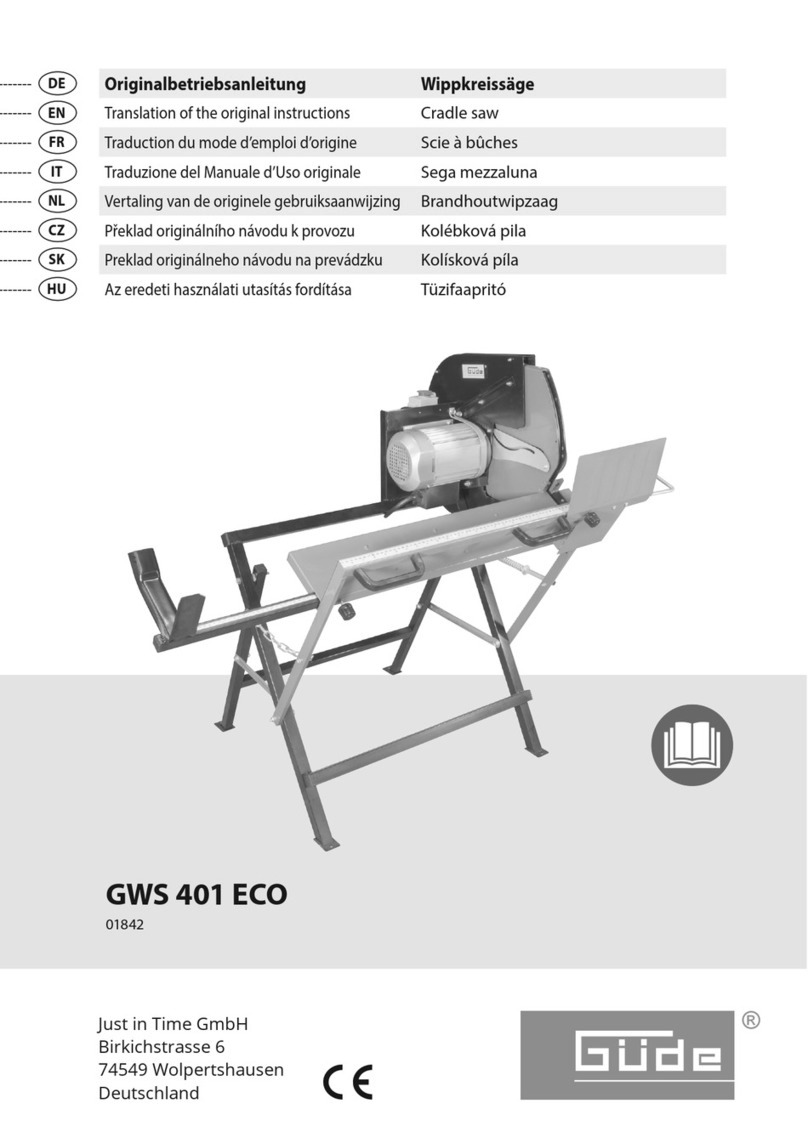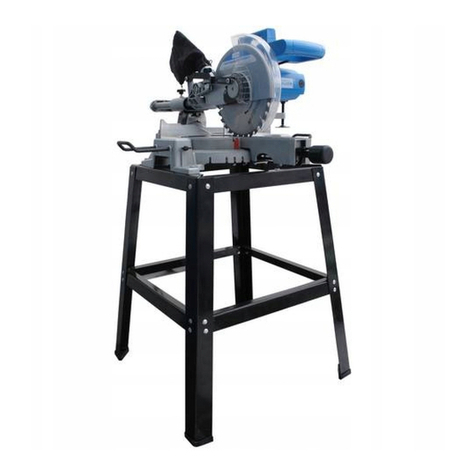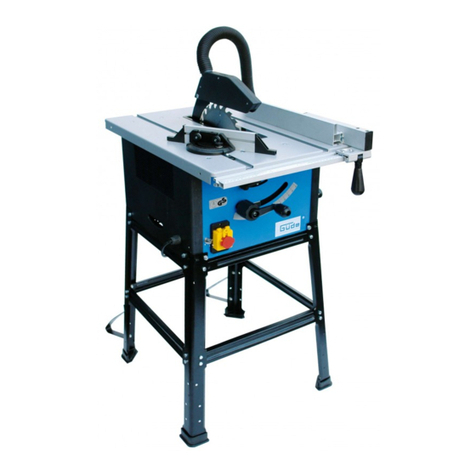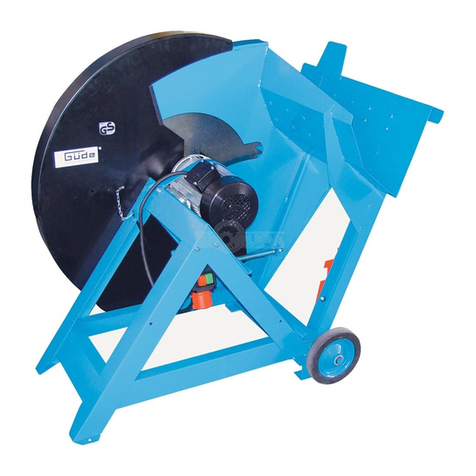
moving parts of the machine. We recommend using
working gloves and anti-slip working shoes for outdoor
works. Long hair must be adequately protected.
•Use personal protective equipment. Protective
glasses and earmuffs must be used at all times. A
respirator is also necessary. Closefitting gloves must
always be used when handling sharp edges and circular-
saw blades.
•Use a dust exhauster. If dust exhaust and collection
equipment is available, it must be fitted and used
properly. Make sure dust and sawdust are always
diverted from you and other persons who are near the
machine.
•Watch out for the feeder cable. Do not pull the cable.
Do not use it to pull the plug out. Keep the cable out of
reach of thermal sources, oil and sharp edges.
•Secure the workpiece. Appropriate clamps, pliers, etc.
to be used. It is always safer than holding the workpiece
by hand. In addition, you have both hands free for work.
•Make always sure your posture is balanced and safe.
Do not incline e.g. too far or away when reaching for
something.
•Remove any tool keys, etc. All keys used for tool
change, etc. must be removed before switching the
machine on.
•Prevent any unintentional switch-on. Before plugging
the machine, make always sure the machine is switched
off on the machine switch.
•When working outdoors, special extension cables to
be used only. For outdoor works, you need special
extension cables suitable for that purpose and bearing
the respective marking.
•Be careful at all times. Pay attention to what you are
doing. Use common sense when working. Do not use
electric tools when you are tired.
•Watch out for any damaged parts. Check the machine
before using it. Are any parts damaged? In case of slight
damage, please consider seriously whether the machine
would still work safely and perfectly. Provide appropriate
adjustment and setting of the moving parts. Do any
elements not fit into each other properly? Are any of
them damaged? Is everything installed properly? Are all
other conditions for perfect machine working satisfied?
Any damaged protective equipment, etc. must be
repaired or replaced by authorised repairmen, unless
otherwise explicitly provided in the Operating
Instructions. Have any defective switches repaired in an
authorised workshop. Do not use the machine when the
switch cannot be turned on/off properly. Replace the
table insert when worn out. If any machine (including
protective equipment and circular-saw blade), defects
are unexpectedly detected, please contact your local
service centre.
•Avoid being hit by electric shock. Avoid body contact
with grounded objects such as water pipes, radiators,
cookers and refrigerators.
•Approved parts to be used only. Only identical spare
parts to be used for any servicing and repair. For that
purpose, contact an authorised service centre.
•Warning! Use of accessory equipment and extensions
not explicitly recommended in these Operating
Instructions may lead to putting persons and objects at
risk.
•Caution: The sliding bar to be necessarily used for all
works.
•Take care of your machine. Keep the cutting tools
sharp and clean – you will work better and safer. Follow
the tool change and lubrication instructions. At regular
intervals, check the machine electric cable and have it
replaced by an authorised professional if damaged. At
regular intervals, check the extension cables and replace
them if damaged. Keep the handles dry, with no oil and
grease.
•Unplug the machine. If the electric tool is not being
used, before any servicing and when changing any tool,
e.g. circular-saw blade, drill, cutter.
•Have your electric tools repaired by an electrician.
This electric tool corresponds to applicable safety
provisions. Any repairs may only be repaired by an
electrician who may only use original spare parts;
otherwise, the user may get injured.
Machine-specific safety instructions
•Prevent any body contact with grounded items.
•Do not use machines where the switch cannot be turned
on/off.
•Unplug the machine for any adjusting and servicing.
•Do not use the saw to cut firewood.
•Avoid any cross cutting of logs.
•Caution! The rotating circular-saw blade represents a
risk of injury for your hands and fingers.
•The machine has been fitted with a safety switch against
repeated switch-on after power failure.
•Before putting the machine into operation, check
whether the voltage on the type label corresponds to the
voltage in the system.
•A cable drum to be used only when unreeled.
•Do not move the saw with the feeder cable.
•Check the feeder cable. Do not use any defective or
damaged feeder cables.
•Do not use the cable to pull the plug out of socket.
Protect the cable against excess temperatures, oil and
sharp edges.
•Remove any wooden waste and items no longer needed
from the place of your work.
•Make sure the engine and circular-saw blade rotation
direction is appropriate.
•In any case, circular-saw blades must not be stopped
with side back pressure after switching the drive off.
•Do not use circular-saw blades not meeting the
specifications in these Operating Instructions.
•It is necessary to make sure that all the equipment
covering the circular-saw blade works perfectly.
•The moving protective cover must not be fixated in an
open state.
•The safety equipment on the machine must not be taken
apart or put out of operation.
•Any damaged or defective protective equipment must be
immediately replaced.
•The cover must be lowered to the workpiece for each
work step.
•It is necessary to use the sliding bar for longitudinal
cutting
of small workpieces.
•When cutting small pieces of wood, the parallel stop on
the right side of the circular-saw blade must be clamped
firmly.
•Caution: This saw must not be used for embedded
sections.
•Working position to be sideways from the circular-saw
blade at all times.
•Do not overload the machine to such an extent it stops.
•At all times, press the workpiece firmly against the
worktop.
•Do not remove any free cuttings, sawdust or stuck
pieces of wood when the circular-saw blade is
rotating.
•Before starting the machine, check whether wrenches
and adjusting tools have been removed.
•All protective and safety equipment must be immediately
refitted after finishing any repair or servicing work.
•Applicable safety regulations and other, generally
recognised safety-technical regulations must be adhered
to.



